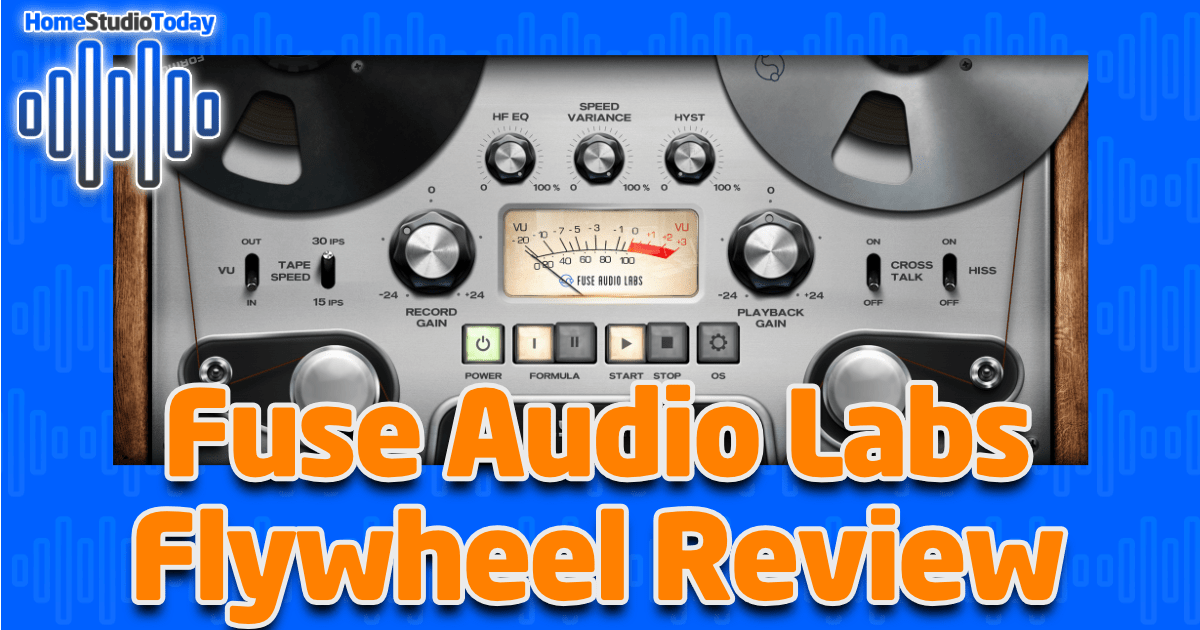If you enjoy this review and decide to grab the deal, please consider clicking through one of my links before you buy. I earn a small commission at no cost to you, which helps support this site and keep the reviews coming. Thanks!
Fuse Audio Labs just released their newest in a series of vintage emulation plugins, their reel-to-reel tape emulator called Flywheel. How will Fuse’s reputation for quality recreations of vintage gear stack up against a robust competition of tape sims? Let’s find out in my review.
Looks
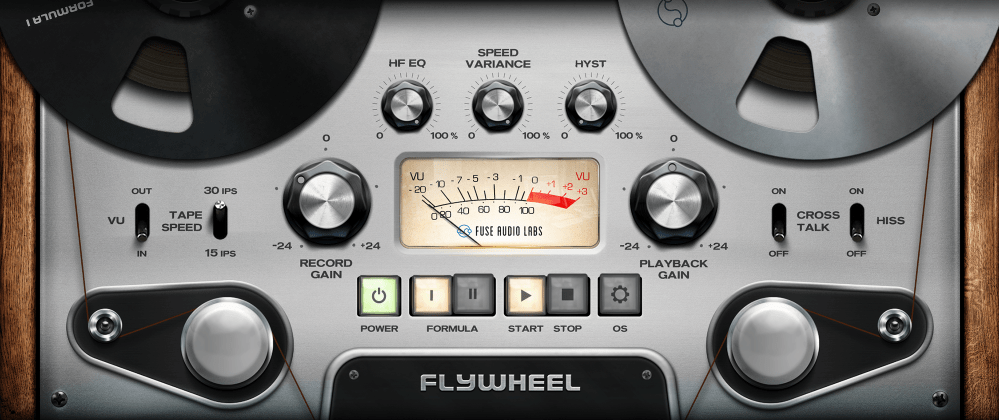
Flywheel has a classic 70s silverface motif with authentic-looking switches and knobs, a backlit VU meter and transport controls, and reels that actually spin. Clicking the Formula I or II buttons changes the left reel from black to red. The interface is sleek and logically laid out, with lots of knobs and switches for tweaking the sound. Fuse has created an attractive GUI with WYSIWYG controls, which is pretty much par for the course for Fuse Audio Labs.

Features
Flywheel comes equipped with more controls than one would expect from a tape emulation plugin, and certainly more than I found in others I have used. Let’s check them all out:
Playhead, Gains, and VU Meter
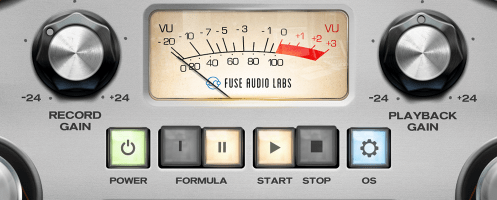
Flywheel‘s playhead controls include a main power, a tape formula toggle for a more linear (I – black) or colored (II – red) tape emulation, a play and stop for realistic-sounding power up and down sounds, and an oversampling toggle to reduce artifacting. The reel animations can be toggled off to save a few CPU cycles by clicking on the reels. Clicking on the VU meter opens a reference calibration menu which lets you choose five calibration models between -18dB and 0dB. The Record gain sets the input signal and therefore the amount of tape saturation that is applied, while the Playback gain allows for loudness matching.
High-Frequency EQ, Speed Variance, and Hysteresis

The High-Frequency (HF) EQ applies an inverse equalization relative to the HF loss caused by the tape playback head, allowing you to dial in the right amount of tape loss for your application. The Speed variance gives wow and flutter to the tape motor and causes variations in pitch as you increase the knob. Hysteresis emulates crossover distortion and high-frequency loss due to tape magnetization.
VU Mode and Tape Speed
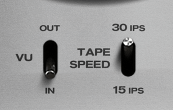
The VU meter can monitor the input or the output signal, and the VU toggle switches between the two options. The Tape Speed switches between 15 and 30 inches per second, with the higher setting having better high-frequency response and lower bass response and the lower setting the opposite.
Cross Talk and Hiss
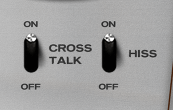
Normal tape machines have a small amount of bleed between the two channels. The Cross Talk switch enables a -60dB bleed when used on stereo sources. The Hiss switch introduces that all-too-familiar magnetic tape hiss.

Usability
In my testing, I found Flywheel to be subtle, but in a good way. Those who are looking for drastic or sweeping changes to their sounds should probably look elsewhere, but those looking to add some fun warmth, saturation, and overall glue to their tracks should definitely give this plugin a closer look. Slapped on a master buss, this plugin brings a ton of cohesiveness, especially when using the Cross Talk feature to bring a bit more of the middle channel back to a wider mix. Added to an acoustic track, I found that it added a pleasant warmth and tamed some high-end harshness.
One thing that struck me right away when I first loaded up Flywheel is that there is no preset loader. There are presets available in the DAW menu, but at first glance they are easy to miss. Personally I’m not a big preset guy, but I do like flipping through them when on first use in order to get some ideas as to what the developer expects the plugin to sound like. I thought that not having a ton of presets to flip through as reference points might take away from the overall usability, but I was proven wrong in short order. Instead, not having a big menu cluttering up the interface and just a few presets to choose from forced me to use my ears to find interesting starting points for different sound qualities. Some may be off-put by that missing feature, but I think it really stretched my ears to hear some the subtle nuances and use them to my advantage.
(In an earlier version of this review, I said that Flywheel doesn’t have presets. That is incorrect, there are nine presets that came with the 1.0 version of Flywheel. The presets aren’t mentioned in the manual and there doesn’t appear to be a preset loader in the plugin, so it’s an easy mistake to make, but I do regret the error. This correction did not affect my overall scoring of Flywheel.)

Hear it in Action
Today’s review comes with three samples. First is a stereo acoustic guitar track with Flywheel on the guitar buss. Cross Talk is turned on, with Formula I (black) tape at 30 IPS. I dialed back the HF EQ just a touch, added a little wow and flutter, and left the Hiss off. I really like the way it adds a warmth and dials back the highs in a way that I couldn’t quite nail with standard EQ.
Next is an acoustic drum VST track produced in MDrummer. I stuck Flywheel on at 15 IPS, Cross Talk on, with HF EQ dialed back to about 60%. I left both gains at noon and used the Formula I tape again. I love how Flywheel again adds warmth, a bit of saturation, and dials back the high-end in a pleasing way.
For the last sample I thought I’d do something a little different and apply Flywheel to a hip-hop track. This track was produced with drum, bass, and acoustic instrument samples from Loopcloud, and I was curious if adding Flywheel on the master buss would calm down some of the wilder high-frequency transients and give the track a bit of glue, and it definitely did. Cross talk was on again, this time with Formula II (red) tape at 15 IPS, with all of the other tape artifacts like wow and flutter turned off.
Fuse Audio Labs Flywheel Review – The Bottom Line
Comparing the price and features to other reel-to-reel sims on the market, Flywheel definitely holds its own in both categories. There are reel-to-reel emulation plugins that cost two to three times as much as Flywheel and don’t offer even half as much control over the final sound output. More than just tape type, speed, and wow and flutter controls, Flywheel kicks it up a notch with realistic hysteresis, cross talk, hiss, and oversampling. Your plugin dollar will stretch much farther with Flywheel, and you’ll get more for that money.

At the end of the day, Fuse Audio Labs has continued their tradition of creating five-star plugins with Flywheel. It’s an excellent value, has more features than the competition, tons of use cases, and is just plain easy and fun to use. I have no doubt that Flywheelwill at least get auditioned on every track I create from now on, as its subtle vintage warmth and saturation is a more than welcome addition to my mixing and mastering arsenal.

Fuse Audio Labs' take on reel-to-reel emulation, featuring two tape formulas, switchable hiss and cross talk, and tons of options for controlling the final sound output.

